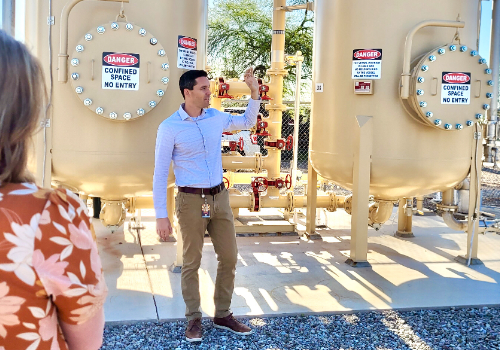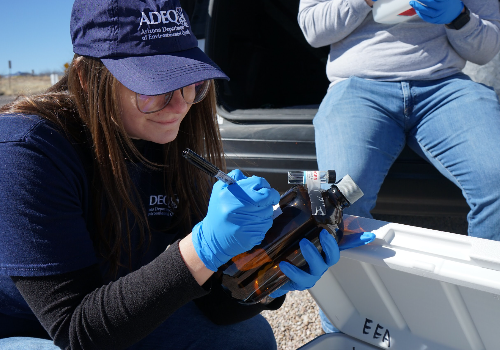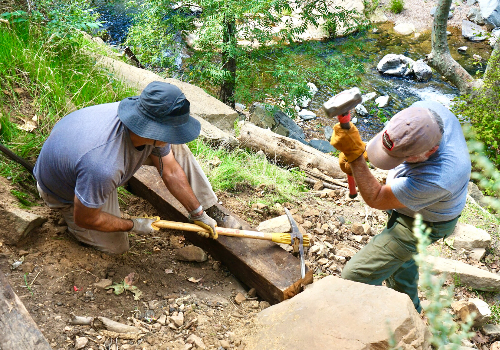By Colleen Kern and Rithwik Kalale
In an era of increasing concern about water accessibility, Arizona faces unique challenges in ensuring safe, clean drinking water for its residents. With the recent Environmental Protection Agency (EPA) regulation on per- and polyfluoroalkyl substances (PFAS) in April 2024, the spotlight on water quality has intensified.
Understanding PFAS and Water Quality Concerns
PFAS, a group of man-made chemicals, have become a significant concern in water quality discussions. Known for their resistance to water, grease, and stains, PFAS are found in everyday products such as nonstick cookware, stain-resistant fabrics, and water-repellent clothing. However, their persistence in the environment and potential health risks have led to increased scrutiny and regulation.

Long-term exposure to PFAS is linked to multiple health issues, including certain cancers, liver damage, thyroid disease, and developmental effects in children. The release of the movie “Dark Waters” in 2019, based on the DuPont water contamination scandal in West Virginia, brought widespread public attention to the PFAS issue. The DuPont case, along with others like the water crisis in Flint, Michigan, from 2014-2016, have underscored the urgent need for stricter regulations and better monitoring of drinking water quality across the nation. But what does this mean for Arizona residents?
Arizona’s Approach to Water Quality

In Arizona, water quality is a top priority, especially given the state’s unique environmental conditions and reliance on groundwater. The Arizona Department of Environmental Quality (ADEQ) plays a crucial role in overseeing and ensuring the safety of drinking water across the state.
Key aspects of Arizona’s approach include:
- Comprehensive Testing: ADEQ regularly tests for over 90 contaminants, including bacteria, arsenic, uranium, nitrates, and PFAS.
- Proactive PFAS Monitoring: In 2022, ADEQ launched a statewide effort to test public water systems for 29 different types of PFAS. This initiative also provides free PFAS sampling to smaller systems, allowing for early detection and mitigation.
- Rapid Response to Contamination: When contaminants exceed safety standards, ADEQ requires public notification and works with water systems to address the issue promptly.
- Support for Small Systems: ADEQ assists small public water systems in building their technical, managerial, and financial capacity to maintain healthy drinking water.
- Predictive Analytics: ADEQ uses a Predictive Analytics program to identify changes and trends in drinking water quality, allowing for preemptive action to prevent water quality violations.
Alma Suarez, deputy public information officer for water quality at ADEQ, emphasizes the state’s commitment.
“ADEQ oversees approximately 1,550 regulated public water systems, serving more than seven million residents. We work with local counties to ensure that tap water quality meets or exceeds state and federal Safe Drinking Water Act (SDWA) standards,” she says.
Suarez explains that as a result of these efforts, drinking water supplies in Arizona are among the cleanest in the country. More than 99.7% of Arizonans who receive their water from a public water system are being served healthy water that meets or exceeds all SDWA standards.
Common Contaminants and Challenges

Alan D. Forrest, president of the Arizona Water Association, identified the most common contaminants found in Arizona’s drinking water: “Nitrates, Arsenic, PFAS, and VOCs (Volatile Organic Compounds – trichloroethylene (TCE), tetrachloroethylene (PCE), methyl tert-butyl ether (MTBE), etc.). All of these are common groundwater contaminants – both in [Arizona] and nationwide.”
Forrest explains that Arizona is a naturally mineralized state; therefore, naturally occurring minerals like arsenic and uranium are present in some groundwater supplies, largely depending on the type of soil and rocks the groundwater is exposed to. These constituents are regulated by the EPA, requiring water companies to either discontinue the use of contaminated water or treat it to remove the contaminants.
Regarding man-made pollutants, Forrest notes that while PFAS regulations are just now being adopted, nitrates have been regulated for decades under both the SDWA and the Clean Water Act. Forrest notes that current treatment technologies are very good at both identifying and removing both known and emerging contaminants.
Future Plans and Initiatives

According to Suarez, ADEQ has several goals to improve and maintain water quality in Arizona:
- Expand technical, managerial, and financial capacity: ADEQ plans to enhance its program that supports small water systems in building their technical, managerial, and financial capabilities.
- Grow the monitoring assistance program: This program helps small systems comply with the Safe Drinking Water Act by assisting with required annual sampling.
- Enhance predictive analytics: ADEQ will continue to develop its predictive analytics program to identify potential water quality issues before they become violations.
- Advanced water purification: ADEQ is working on finalizing regulations for advanced water purification — a groundbreaking initiative to convert treated wastewater into safe, reliable, purified drinking water. The initiative addresses both water quality and quantity concerns in Arizona’s arid environment.
- Address emerging contaminants: ADEQ remains vigilant about emerging water quality concerns, particularly PFAS contamination. The department has already launched a comprehensive statewide effort to test for 29 types of PFAS and is continually updating its approach based on new federal guidelines.
These initiatives demonstrate ADEQ’s commitment to proactively addressing Arizona’s water challenges and ensuring safe, clean drinking water for all residents.
Reducing Your Exposure
While water utilities work to implement new standards and improve water quality, there are initiatives that you can take to reduce your exposure to PFAS and other contaminants on your own:
- Use certified water filters: Look for charcoal (granular activated carbon or GAC) or reverse osmosis filters and systems certified for PFAS reduction. These are often marked with certification to “NSF/ANSI 53” or NSF/ANSI 58.”
- Stay informed: Review your water system’s annual Consumer Confidence Report (CCR) for detailed information about your water quality.
- Avoid PFAS products: Limit the use of products containing PFAS, such as certain non-stick cookware and water-repellent clothing.
- Support clean water initiatives: Advocate for stricter regulations on industrial pollutants and support initiatives aimed at improving water quality in your community.
- Test private wells: If you rely on a private well for drinking water, consider having it tested for contaminants regularly.
Where to Learn More
For residents seeking more information about water quality in Arizona, several resources are available:
- ADEQ website (azdeq.gov): Provides access to detailed reports, interactive maps, and resources on water quality.
- Consumer Confidence Report (epa.gov/ccr): The Report provides detailed information about your drinking water, which is often provided by your water supplier or can be found on the EPA’s website.
- EPA’s PFAS information page (epa.gov/pfas): Offers comprehensive resources on PFAS, including health information and regulatory updates.
As we move forward, the importance of clean water cannot be overstated. It’s not just about meeting regulatory standards; it’s about safeguarding public health, supporting our communities, and preserving Arizona’s water resources for future generations. Through continued research, public engagement, and adaptive management strategies, Arizona can strive to ensure that every resident has access to clean, safe drinking water.





